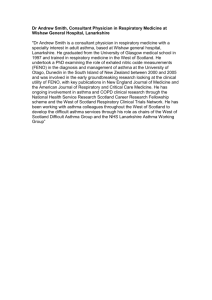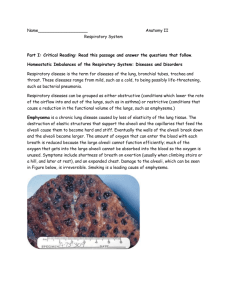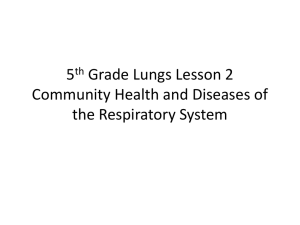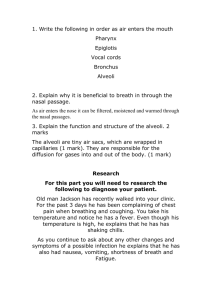Word File
advertisement
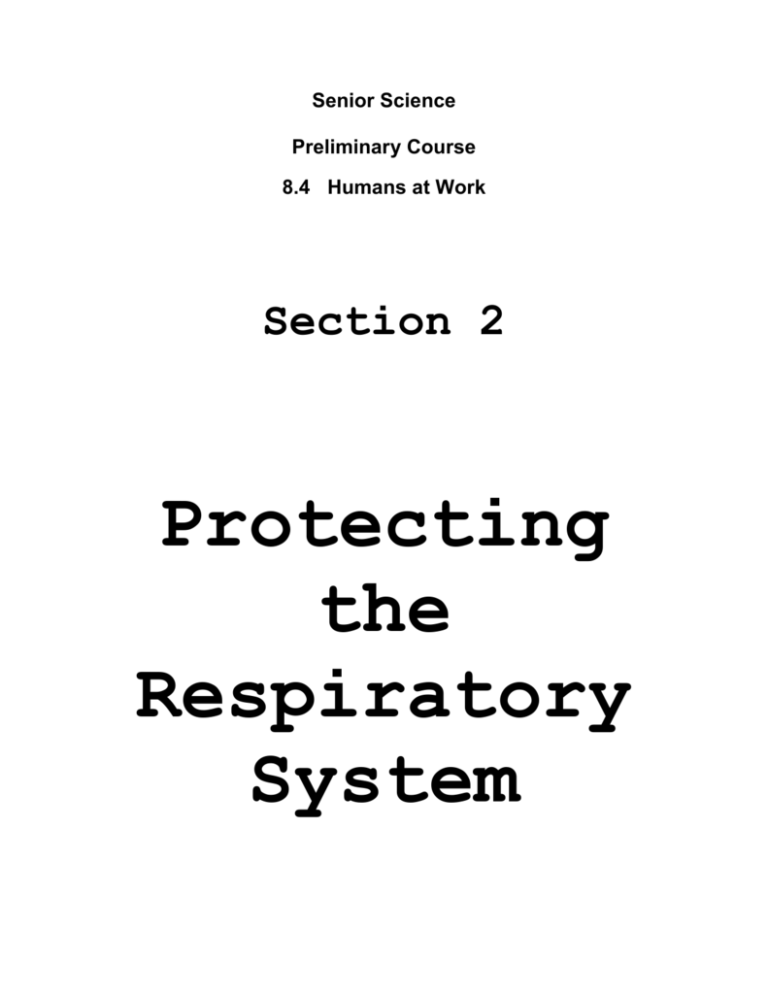
Senior Science Preliminary Course 8.4 Humans at Work Section 2 Protecting the Respiratory System PW C:\MY DOCUMENTS\PETER\SENSC\HUMANS AT WORK\HUMANS – NOTES02.DOC Section 2 ::: Protecting the Respiratory System Focus area – Potential risks to the respiratory system can be minimised by implementing protective measures. 8.4.2.a Account for the moist lining of the lungs in terms of the need to dissolve oxygen so it can diffuse through to the blood 8.4.2.b Outline the purpose of mucous production and the role of cilia on epithelial tissue in the lungs. 8.4.2.c Outline the effect of chronic exposure to inhaled solids on lung tissue. 8.4.2.d Identify safety procedures and equipment in the school and workplace including fume cupboards, filtering masks, filters, dust extractors/fans and adequate ventilation 8.4.2.i Gather, process, analyse and present information from secondary sources on one respiratory condition caused by environmental factors and include: cause, effect on respiratory system, symptoms, prevention and current directions in research to reduce the problem. © P Wilkinson 2002-04 2 PW C:\MY DOCUMENTS\PETER\SENSC\HUMANS AT WORK\HUMANS – NOTES02.DOC Introduction In large organisms a system of specialised structures or organs – called the respiratory system – is needed to supply the body with oxygen and remove carbon dioxide. The air that you breathe in enters your body through your nose (via the nostrils into the nasal cavity) and mouth. The hairs and sticky mucous in your nose, trap dust, dirt and other harmful material, like disease causing bacteria. Breathing in through your mouth gets the air in faster but without being filtered by the nose. After entering your nasal cavity, the air moves past the pharynx, into a narrow tube called the trachea. At the top of the trachea is a flap of tissue called the epiglottis, and a structure called the larynx (voice box). The job of the epiglottis (a tissue) is to stop food going down into your lungs. If food does manage to pass it and 'go down the wrong way' a cough soon brings it back up again. The trachea divides into two narrower tubes called the bronchi. Each of these tubes leads to a lung. Inside the lung, each tube divides into many smaller tubes called bronchioles. The bronchioles branch out, getting smaller and smaller until they end at thousands of sacs called alveoli. There are a large number of alveoli, approximately 700 million. This gives a large surface area for the rapid exchange of the gases, oxygen and carbon dioxide. A large number of capillaries (a capillary network) surround each alveolus. Blood flows in via a capillary to this network and then flows out via another capillary. Air flows in and out the same opening in the alveolus. Gas is exchanged (oxygen in; carbon dioxide out) in the alveoli. Surrounding and protecting the lungs are the ribs. The diaphragm is a muscle at the bottom of the chest cavity and is involved in breathing. Notes Questions 1. What is the purpose of the respiratory system? 2. What does the mucous in your nose do? 3. What is the disadvantage of breathing through your mouth? 4. What is the purpose of the epiglottis? 5. How many alveoli are there in your lungs? 6. What happens in each alveolus? 7. What part of the skeleton protects the lungs? 8. Draw a flow-chart of the structures in the respiratory system passed by air as it is breathed in. 9. Copy and label the diagram of the respiratory system using the information given above. © P Wilkinson 2002-04 3 PW C:\MY DOCUMENTS\PETER\SENSC\HUMANS AT WORK\HUMANS – NOTES02.DOC 8.4.2.a Account for the moist lining of the lungs in terms of the need to dissolve oxygen so it can diffuse through to the blood Where the action is. It is at the alveoli that the exchange of gases actually takes place. Once in the alveoli, oxygen moves through the walls of the alveoli and the capillary wall before entering the capillaries. There it attaches onto the red blood cells and is carried to all body cells. Carbon dioxide takes the opposite journey, moving out of the body's cells to the red blood cells, and then through the capillary and alveoli walls into the alveoli so it can be breathed out. For the exchange of gases to occur rapidly & efficiently, the lungs have special features. 1. Oxygen and carbon dioxide don’t simply flow through the walls of the alveoli and capillaries. The two gases must first dissolve in water. The water then carries the gases across the alveoli & capillary wall by diffusion [i.e. oxygen moves into the blood and carbon dioxide moves into the alveoli]. For this reason the inner surface of the alveoli is thin and moist. Oxygen does not dissolve easily in water. To make sure enough oxygen enters the blood stream the lungs have a huge surface area and a plentiful blood supply. 2. The lungs have a huge surface area. There are 350 million alveoli in each lung. If they were laid out flat they would cover 100 square metres. So each time you breathe in and refill the alveoli with air, this air is held in contact with the blood over a huge area. 3. The lungs have a plentiful blood supply; the surface of each alveolus is in contact with blood in the capillaries. © P Wilkinson 2002-04 4 PW C:\MY DOCUMENTS\PETER\SENSC\HUMANS AT WORK\HUMANS – NOTES02.DOC Notes Questions 10. Complete the flow chart Oxygen in alveoli Through Oxygen attached to red blood cell Carbon dioxide in blood 11. What is the type of blood vessel that is in contact with the alveoli? 12. Research What is diffusion? 13. Why is the inner surface of the alveoli moist? 14. Why is the inner surface of the alveoli thin? 15. Name the lungs three special features that allow gas exchange to occur efficiently. © P Wilkinson 2002-04 5 PW C:\MY DOCUMENTS\PETER\SENSC\HUMANS AT WORK\HUMANS – NOTES02.DOC 8.4.2.b Activity Outline the purpose of mucous production and the role of cilia on epithelial tissue in the lungs. Keeping the Respiratory System Clean The air we breathe in contains many particles, which could eventually clog up or infect the lungs. To prevent this the respiratory system has certain features: 1. Hairs line the nasal cavity. These hairs are mucus-coated. The hairs filter the inhaled air, trapping microorganisms, and particles such as dust and pollen. 2. Mucus also lines the airways. The purpose of mucus is to trap microorganisms and dust particles that are carried by the air into the lungs. The mucus and trapped material can then be removed from the body. 3. Microscopic hairs called cilia, line the trachea and the other air tubes in the lungs. The role of the cilia is to remove foreign material trapped by the mucus lining. The cilia beat in a coordinated way to keep a light film of mucus moving upwards out of the trachea. Any dust particles and bacteria trapped in the mucus are removed from the trachea and can be swallowed into the stomach. © P Wilkinson 2002-04 6 PW C:\MY DOCUMENTS\PETER\SENSC\HUMANS AT WORK\HUMANS – NOTES02.DOC 4. Sometimes microorganisms and other particles pass through the lines of defence, provided by the mucus and cilia. When this happens, other internal defences of the body make an effort to destroy them. Cells, when damaged by the presence of the foreign particles, release special chemicals that make the blood flow to this area more rapidly. A large number of white blood cells arrive in the area. The role of the white blood cells is to attack the invading foreign particles in an effort to destroy them. They leave the blood vessels and enter the lung tissue. Here the white blood cells ‘engulf’ the foreign particles (dust, bacteria). The cells are then moved up the respiratory tract to the throat by the cilia and then swallowed. Material to be Phagocytosed (eg. bacterium) Material to be phagocytosed becomes Attached to cell membrane of phagocyte Cell membrane of phagocyte flows around the material to be ingested (in an ‘amoeboid’ fashion) – until it is enclosed within a vacuole in the phagocyte. Coughing and sneezing also helps to remove unwanted microorganisms and particles. Coughing helps to clear the nasal and upper respiratory tract by moving mucus, which contains microorganisms into the throat. It is then swallowed, and the secretions of the digestive system destroy the microorganisms. Sneezing helps to clear foreign material, including microorganisms from the nasal passages. It also assists the movement of mucus into the throat where it is swallowed. Notes Questions 16. What substances are trapped by mucus? 17. Where can cilia be found in the respiratory system? © P Wilkinson 2002-04 7 PW C:\MY DOCUMENTS\PETER\SENSC\HUMANS AT WORK\HUMANS – NOTES02.DOC 8.4.2.i Gather, process, analyse and present information from secondary sources on one respiratory condition caused by environmental factors and include cause, effect on respiratory system, symptoms, prevention and current directions in research to reduce the problem. This activity can be completed electronically. 1. Open your email to: find the information about asthma and the two questions to be completed. 2. Save this to a WORD document 3. Use the cut and paste tools in WORD to: Cut the appropriate information from the passage above and then Paste this information under the appropriate question. 4. Then complete the table by summarising the information you have collected. 5. Finally email your answers to your teacher (as directed) Information – About asthma What causes asthma? Asthma is an allergic response. Asthma is a respiratory condition caused by ‘triggers’ in the environment. Some of the common triggers of an asthma attack are: Vigorous exercise Cold weather Cigarette smoke Dust and dust mites Moulds Pollen Air pollution Some foods and food additives It is not known why some people get asthma and others do not. It seems that it can be inherited but many people from families without a history of asthma are affected. Asthma is certainly the result of sensitive airways. An asthma attack occurs when those sensitive airways are triggered Asthma is a very common condition, which affects about one in seven Australian adolescents. About one in ten or 10 per cent of adults are affected. Young children are the greatest sufferers of asthma with one in four affected. One alarming fact about asthma is that the number of people who suffer from it has doubled in the last 30 years. Asthma sufferers are not affected by the same triggers. Some people only suffer attacks as a result of exercise. Other people may suffer an asthma attack due to any © P Wilkinson 2002-04 8 PW C:\MY DOCUMENTS\PETER\SENSC\HUMANS AT WORK\HUMANS – NOTES02.DOC one of several triggers. It is important that those who suffer from asthma try to find out what triggers the attacks. Many of the triggers can be avoided. What is Asthma – effects and symptoms? Asthma is a narrowing of the airways that join the mouth and nose to the lungs. The most affected are the bronchi. They become narrower as: The muscle wall of the air pipes contracts The lining of the air pipes swells Too much mucus is produced The narrow pipes make breathing difficult and can result in wheezing, coughing and a tight feeling in the chest. The coughing is usually worse at night. Controlling the Triggers - prevention attacks is to avoid the triggers. The best way to control or prevent asthma Pollen from grasses and trees is very light and becomes airborne on even slightly windy days. Inhaling pollen can be reduced by: avoiding outdoor activities, and keeping windows and doors closed on breezy spring days. Moulds live in warm, humid conditions and thrive in bathrooms, kitchens and bedrooms. Their spores are easily breathed in, triggering attacks in some asthma sufferers. Airing the house regularly can reduce moulds, and therefore avoid this trigger. Dust mites are a common trigger of asthma attacks. Dust mites are microscopic animals that live in warm, moist and dark places like doonas, sheets, pillows, carpets and curtains. Dust mite droppings float in the air and are easily inhaled. Even the cleanest house has dust mites, but their numbers can be reduced by: Using special dust mite covers on mattresses and pillows Airing all rooms regularly Regular vacuuming of curtains and carpets Removing carpets and replacing them with polished floorboards. Dust mites thrive best in bedding and carpets because these contain plenty of dead human skin cells, which they eat. Humans shed a complete layer of dead skin cells every month. That amounts to about 1 kilogram of skin cells each year. Asthma medication Asthma medications can be divided into two main groups, preventers and relievers. Preventers make the lining of the airways less sensitive and therefore les likely to be triggered. Relievers open up the airways once an attack has commenced. Most asthma medications are applied with inhalers or ‘puffers’, which direct the medication straight into the air tubes for fast action. Severe attacks of asthma require other drugs and sometimes extra oxygen needs to be supplied. Research There is no cure for asthma. However, there is a lot of research being carried out. Researchers are investigating asthma from a number of directions. Some researchers are considering ways of how to identify the triggers for particular people. This will help people avoid the trigger for their asthma. Some research is occurring into © P Wilkinson 2002-04 9 PW C:\MY DOCUMENTS\PETER\SENSC\HUMANS AT WORK\HUMANS – NOTES02.DOC cell biology to better understand how the body reacts to particular triggers. It may be eventually possible to develop medicine that prevents the asthma attack. The research will help scientists better understand why the body reacts to produce an asthma attack. It may help to develop more effective treatments of asthma. Questions 1. Process and analyse the information to complete the following: Outline the cause. [2 marks] Describe the effect on the respiratory system. Identify the symptoms. [3 marks] [1 marks] Outline methods of prevention. [2 marks] Identify current directions in research to reduce the problem. Marking Criteria [2 marks] Identify questions (iii, v) Name symptoms or current directions Marking Criteria Marks 1 or 2 Outline and Describe (i, ii, iv) Marks Provide at least 2 or 3 important features of cause, effects, methods 2 or 3 Provide at least 1 or 2 important features of cause, effects, methods 1 or 2 2. Summarise your information using a table (no larger than two lines per section). [5 marks] Respiratory condition caused by environmental factors Cause Effect on respiratory system Symptoms Prevention Current direction in research Marking Criteria Marks Key point or points mentioned for all sections Points mentioned for all sections that are not key points Too much information provided; Information provided not summarised © P Wilkinson 2002-04 10 5 1-4 PW C:\MY DOCUMENTS\PETER\SENSC\HUMANS AT WORK\HUMANS – NOTES02.DOC Research Activity The history of understanding asbestosis What to do Use the following Internet sites (and others) to increase your knowledge of the respiratory disease – asbestosis www.wartnicklaw.com/history.htm www.elslaw.com/medhistory.htm www.btinternet.com/~ibas/lka_ards.htm www.hunter.cuny.edu/health/eohs/asbcmnts.html www.mesothel.com/pages/medhx_pag.htm www.asbestosis-info.com/ Questions 1. Process and analyse information about asbestosis to complete the following: i. Describe the element asbestos. [2 marks] ii. Identify three uses for asbestos. [1 mark] iii. Describe asbestosis. [3 marks] iv. Identify the cause of asbestosis. [1 mark] v. Describe the effect of asbestosis on the respiratory system. [3 marks] vi. Identify the symptoms a sufferer of asbestosis may experience. [2 marks] vii. Is asbestosis a condition that can be cured/treated/prevented? [1 mark] viii. Explain, using examples, why asbestosis is a controversial disease and has resulted in legal action. [5 marks] Marking Criteria Identify questions (ii, iv, vi) Name uses, causes or symptoms Marking Criteria Marks 1 or 2 Describe (i, iii, v) Marks Provide at least 2 or 3 important features of asbestos, asbestosis, effects 2 or 3 Provide at least 1 or 2 important features of asbestos, asbestosis, effects 1 or 2 Marking Criteria Explain (viii) Marks Provide at least two examples Each example should relate examples to Outline some legal action that has resulted © P Wilkinson 2002-04 5 11 PW C:\MY DOCUMENTS\PETER\SENSC\HUMANS AT WORK\HUMANS – NOTES02.DOC 2. Draw a timeline of the development of understanding of asbestosis. [12 marks] Include ten to fifteen important dates The timeline has been started for you. Date BC Marking Criteria Related information A Roman Historian, Pliny the elder, classifies injuries caused by weaving asbestosis as a ‘disease of slaves’. Describe (i, iii, v) Marks Provide at least 2 or 3 important features of asbestos, asbestosis, effects 2 or 3 Provide at least 1 or 2 important features of asbestos, asbestosis, effects 1 or 2 3. Summarise your information using a table (no larger than two lines per section). [6 marks] Respiratory condition caused by environmental factors Cause Effect on respiratory system Symptoms Prevention Current direction in research Marking Criteria Marks Key point or points mentioned for all sections 5-6 Points mentioned for all sections that are not key points Too much information provided; Information provided not summarised 1-4 4. Provide a list of references used © P Wilkinson 2002-04 [2 marks] 12



